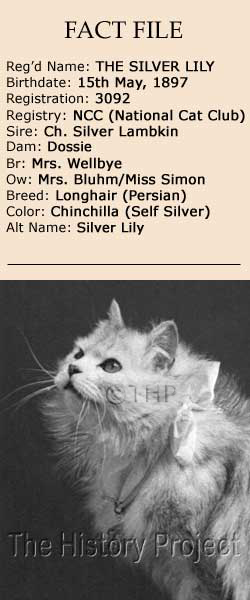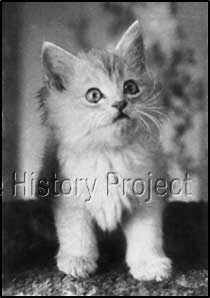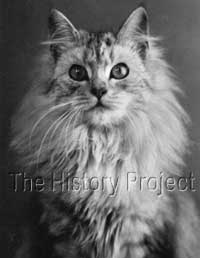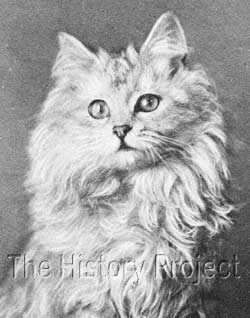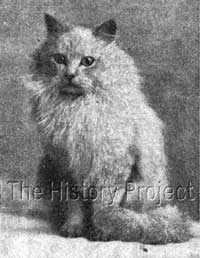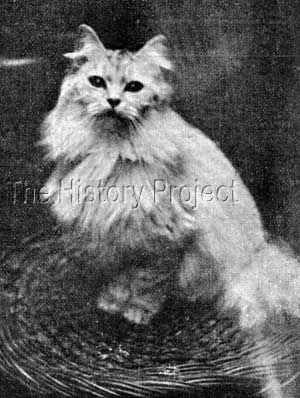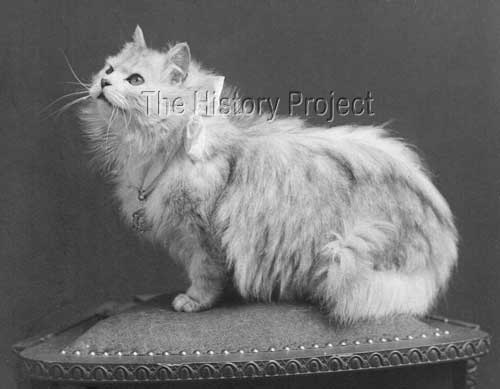 | ||||||||||||||||||||||||









|
THE SILVER LILY (1897)PHOTOS | SOCIAL MEDIA | REFERENCES
HISTORICAL BACKGROUND:'The Silver Lily' is arguably the most renown of all of the progeny from 'Dossie' and 'The Silver Lambkin'. Along with her full and half siblings, she represented an equal first at the peak of attainment for the Chinchilla breed, at a time when everyone was seriously striving to breed for 'clarity of coat', free from barring, the lighter the better. In this respect she was ahead of litter sister 'Silver Jessamine' who was more shaded and was more barred. Both were prized daughters of an outstanding foundation sire, so their value also lay in their potential as breeders and to produce an improved generation of silvers, that everyone hoped would show promise of even clearer coats, in the quest for what was then, the 'self silver'. This quest was erroneous in the respect that such a cat does not exist, as all silvers are not self coloured, but tipped. So in reality, the quest was only a search for a coat free from barring and of the very lightest of shades, essentially with colour restricted to only the very tip of the hair shaft. That the breeders did ultimately achieve this goal, in what in reality was a very short space of time, is nothing short of remarkable. This was especially so, given the lack of genetic knowledge, and without an understanding of the 'Inhibitor' gene. Amazingly, many breeders had begun to realise that the use of smokes in the background (which today we know are 'non-agouti'), helped to clear the coats of barring, inherited initially from the Silver tabby (agouti) background. From when 'Ch. Silver Lambkin' was born in 1889, to when the first relatively unbarred specimens started appearing around 1900, then to a time when the ticking was also limited to the very tips and no longer appeared 'shaded', was a space of approximately only 20 plus years. During this time also, the allowable eye colour which originally included both 'green' and 'yellow' eyes, was generally accepted by the majority to be "preferably green", with the standard for the Chinchilla in time, eventually being amended to only 'green' as acceptable. "Lily' (also known as 'The Silver Lily') was one of those rare cats that was a great show specimen, but also valued as a breeder. Amazingly, she was successful at both. PARENTAGE & OWNERSHIP:'Silver Lily' was born 15th May 1897, bred by Mrs Wellbye. Her sire was the timelessly memorable 'Ch. Silver Lamkin' owned by Mrs Balding, and her dam was 'Dossie', a very modest Chinchilla female owned by Mrs Wellbye and bred by Lady Fitzhardinge.² We know little about her ownership, other than she is listed in the National Cat Club Register as owned by Mrs Bluhm, for whom she clearly had a number of litters. But she is shown later, possibly upon her retirement from breeding, on her named studio photograph, taken by W.Muntz of Southport, as being the property of Miss Simon. This image is clearly overprinted with title, 'The Celebrated Silver Lily'.
Eng Ch Perso
Ch Silver Lambkin, Chinchilla
| Beauty of Bridgeyate
The Silver Lily, May-15-1897, Chinchilla, F
| Mr. York
Dossie, Chinchilla
May
SIBLINGS & SHOWS:Of siblings, 'Silver Lily' has just one full litter sister, 'Silver Jessamine', but also a younger full brother in 'Silver Monarch' born two years later, and in between these litters, two dam-siblings, sired by 'The Silver Squire' (aka'The Squire') which were 'Silver Lotus' and 'Silver Veronica'(aka St. Veronica). 'Silver Jessamine' appears to have been the 'poster girl', popular with the public, possibly because of her very expressive eyes, as she appears on a number of postcards in both black and white and early colour printings, either in embossed or plate sunk formats, showing her face in rounded frames or as a full frontal portrait. 'Silver Lily' by comparison, was hardly ever seen, unless shown as a cute kitten, in conjunction with her equally cute litter sister, usually subtitled as 'Dossies Daughters'.
In the above two photographs we are shown 'Dossie's daughters' but which? In an alternative pairing of photographed kittens from a later litter to a male called 'The Silver Squire', these are always denoted as 'The Daughters of The Squire', but in this case, the appellation is simply 'Dossie's Daughters'. So we are inclined to believe that in this case, the above images are representative of the baby 'Jessamine' and 'The Silver Lily'. Certainly the kitten on the right in the first photo above is the clearer coated and the kitten shown in the second image is one and the same kitten. Comparing the adult photos to the kitten photos, we are therefore inclined to accept that the kitten on the right is 'The Silver Lily' as a young kitten.
In the above photo portraits we see 'Silver Lily's' full litter sister, born 15th May, 1897 'Silver Jessamine' (aka Jessamine), and her full younger brother from a repeat breeding, 'Silver Monarch', born 1st June, 1899. Both bear a striking resemblance to their famous sire, but with 'Jessamine' showing a more feminine expression, while her younger brother, although similar, displaying the more well-developed, fully rounded expression you would expect to find in a young male. Notable half-siblings Having already bred 'Dossie' the previous year, directly and successfully to 'Ch. Silver Lambkin' with excellent results, in 1898, Mrs. Wellbye chose to try a variation, and this time chose to breed 'Dossie' to another of Mrs. Balding's males, a son of 'Ch. Silver Lambkin' known as 'The Silver Squire'. This was a move with exceptional foresight, as 'Silver Squire' was the product of a half-brother to half-sister mating, doubling on the dam of 'Ch. Silver Lambkin' himself. When Mrs. Wellbye had bred 'Dossie' directly to 'Ch. Silver Lambkin' and produced both 'Jessamine' and 'The Silver Lily', she had simply doubled on 'Ch. Silver Lambkin's' dam, through Dossie's grandsire, 'Charlbury Silver King'. But by choosing to breed to 'Silver Squire', she was in fact choosing to TRIPLE exclusively on 'Beauty of Bridgeyate' From this breeding came two more females and a male, the females being photographed extensively by E.Landor(Ealing) both as kittens and young cats and who became well known simply as "the daughters of The Squire". The male was registered as 'Lucifer', but although he is listed under Mrs Wellbye's name, there are no photographs extant and no records of any progeny from him.
Both females however, were shown very successfully as can be attested to by the commentary of Frances Simpson in 'The Book of the Cat' (1903) in which she states:
Of show wins for 'The Silver Lily' we have only those listed at the time of her registration in the Register of the National Cat Club. These were: 1st and 2nd, Crystal Palace 1898. BREEDING & PROGENY:Although breeding records are sketchy at best, we have tracked four litters from 'The Silver Lily'. The earliest is a breeding which took place to 'Shah' (most probably 'Shah of Lyndhurst' born in 1892), which produced a Chinchilla female named 'Silver Patti', born 28th July 1898. The breeder is recorded as Mrs. Bluhm (who owned the probable sire), and the owner as Mrs. Earwalker.10 From a second known litter born on 2nd April, 1900, sired by Mrs. Bluhm's 'The Silver Sultan', came two notable kittens, a male, named 'Cairo Ramadan'10 (aka 'Cairo Ramaden'), originally owned by Mrs. Parker Brough, (and later by Miss E.Bonner)11, and a female named 'Ashbrittle San Toy', owned by Mrs. Clarke. Fortunately, we were able to trace images of both of these young cats.11
The last litter of record, but by no means the least famous, is undated but could not have been born earlier than 1902 and probably not until 1903 or 1904. This was from a breeding to 'The Silver Knight', himself a son of 'The Silver Sultan' born 2nd May 1901. From this mating came 'The Silver Lily Boy' (date of birth also unknown), but whose own first recorded litters date from 1907. This valuable son of 'The Silver Lily' bears her famous name, and went on to sire 'Silver Robin' born 27th May 1908, who is found on a number of pedigrees dating from a later period. PHOTOS:
There can be no doubt, that, 'The Silver Lily' was the daughter of the great 'Ch. Silver Lambkin' with the 'wow' factor. There can be little doubt that it was seeing cats such as this that drove breeders to keep the dream of the Silver Persian alive, encouraging the many who shared in that dream, to strive even further. In drawing our attention to the most famous progeny of 'The Silver Lambkin' Frances Simpson, in 'The Book of The Cat' (1903) lists several notable males, but only the one notable female, Mrs. Bluhms 'The Silver Lily'. In addition, only a handful of females have been given the distinction of being accorded the title of 'The' before their name, to signify the wide popularity and respect that they have earned. In Chinchilla's only two come immediately to mind, 'The Seraph' (born 1896) and 'The Silver Lily' (1897). The above photo is possibly one of the best and certainly the clearest, of any of the direct progeny of 'The Silver Lambkin'. It contains an intangible quality, a promise of things hoped for, but yet unseen. SOCIAL MEDIA :None currently available. REFERENCES:
Registers associated with this article include The Incorporated Cat Fanciers Association of Great Britain (TICFAGB), National Cat Club (NCC), The Cat Club (CCR), Beresford Cat Club (BCC), Feline Federation Francaise (FFF), Siamese Cat Registry (SCR), US Register & Studbook for Cats (USR)including Supplement(USRS), The Studbook of the American Cat Association (ACA), and the Studbook & Register of the Cat Fanciers' Association (CFA).
|
|||||||||||||||||||||||
Home | Cats | Gallery | Clubs | People | Artifacts | Articles | Updates | Contact Us ©The CFA Foundation, Inc and The Harrison Weir Collection
|
||||||||||||||||||||||||
